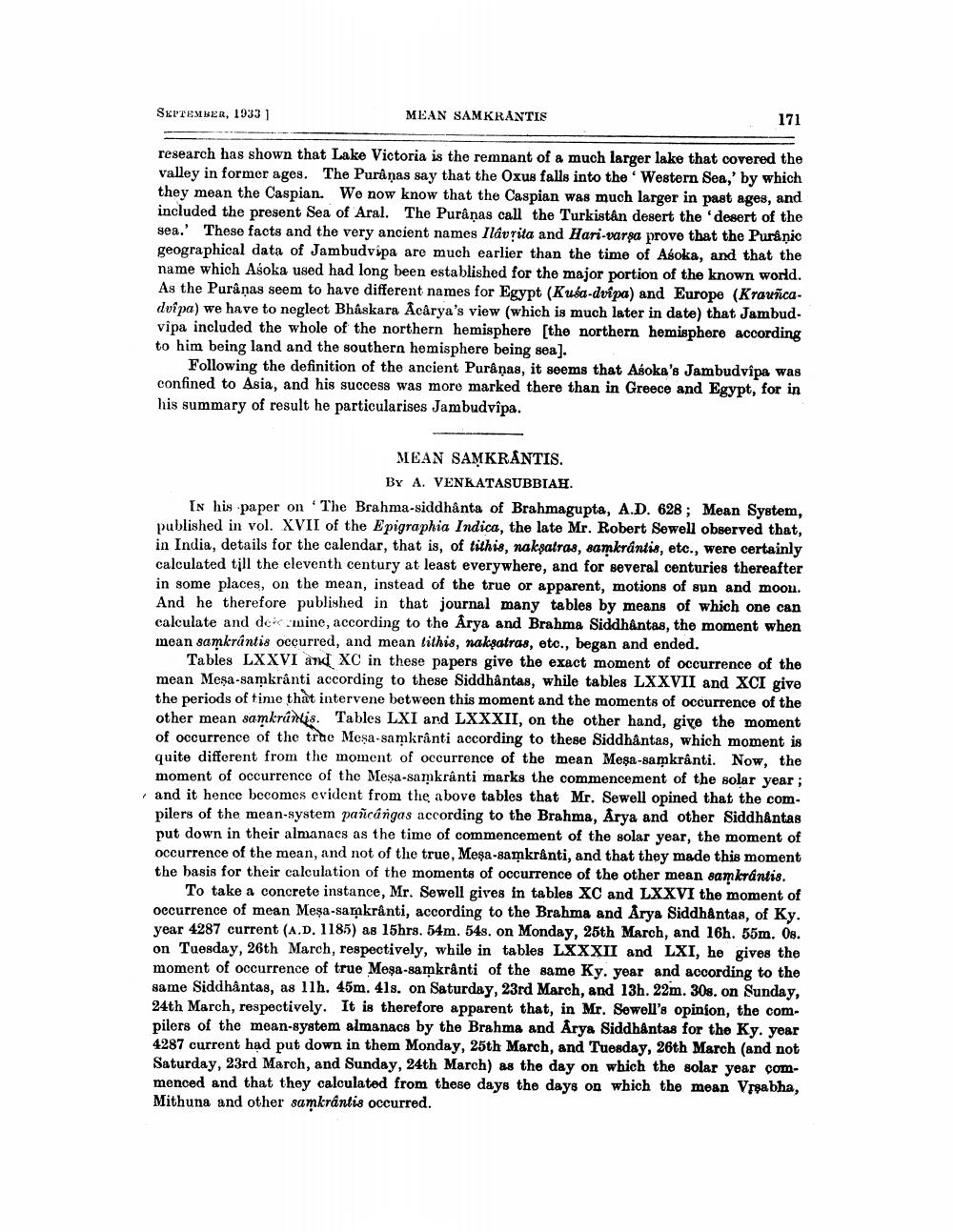________________
SEPTEMBER, 1933 1
MEAN SAMKRANTIS
171
research has shown that Lake Victoria is the remnant of a much larger lake that covered the valley in former ages. The Purâņas say that the Oxus falls into the Western Sea,' by which they mean the Caspian. We now know that the Caspian was much larger in past ages, and included the present Sea of Aral. The Purâņas call the Turkistán desert the desert of the sea. These facts and the very ancient names Ilavrita and Hari-varpa prove that the Puranic geographical data of Jambudvipa are much earlier than the time of Asoka, and that the name which Asoka used had long been established for the major portion of the known world. As the Purâņas seem to have different names for Egypt (Kusa-dvipa) and Europe (Krauñca. dvípa) we have to neglect Bhaskara Acarya's view (which is much later in date) that Jambud. vipa included the whole of the northern hemisphere [the northern hemisphere according to him being land and the southern hemisphere being sea).
Following the definition of the ancient Purâņas, it seems that Asoka's Jambudvipa was confined to Asia, and his success was more marked there than in Greece and Egypt, for in his summary of result he particularises Jambudvipa.
MEAN SAMKRANTIS.
By A. VENKATASUBBIAH. In his paper on The Brahma-siddhanta of Brahmagupta, A.D. 628; Mean System, published in vol. XVII of the Epigraphia Indica, the late Mr. Robert Sewell observed that, in India, details for the calendar, that is, of tithis, nakpatras, samkrantis, etc., were certainly calculated till the eleventh century at least everywhere, and for several centuries thereafter in some places, on the mean, instead of the true or apparent, motions of sun and moon. And he therefore published in that journal many tables by means of which one can calculate and demine, according to the Arya and Brahma Siddhantas, the moment when mean samkrántis occurred, and mean lithis, nakşatras, etc., began and ended.
Tables LXXVI and XC in these papers give the exact moment of occurrence of the mean Meşa-samkranti according to these Siddhântas, while tables LXXVII and XCI give the periods of time that intervene between this moment and the moments of occurrence of the other mean samkranis. Tables LXI and LXXXII, on the other hand, give the moment of occurrence of the true Mesa-samkranti according to these Siddhantas, which moment is quite different from the moment of occurrence of the mean Meşa-samkranti. Now, the moment of occurrence of the Mesa-samkranti marks the commencement of the solar year; and it hence becomes evident from the above tables that Mr. Sewell opined that the compilers of the mean-system pancangas according to the Brahma, Arya and other Siddhantas put down in their almanacs as the time of commencement of the solar year, the moment of occurrence of the mean, and not of the true, Meşa-samkranti, and that they made this moment the basis for their calculation of the moments of occurrence of the other mean samkrantis.
To take a concrete instance, Mr. Sewell gives in tables XC and LXXVI the moment of occurrence of mean Meşa-samakrânti, according to the Brahma and Arya Siddhantas, of Ky. year 4287 current (A.D. 1185) as 15hrs. 54m. 54s. on Monday, 25th March, and 16h. 55m. 08. on Tuesday, 26th March, respectively, while in tables LXXXII and LXI, he gives the moment of occurrence of true Meşa-samkranti of the same Ky. year and according to the same Siddhantas, as 11h. 45m. 418. on Saturday, 23rd March, and 13h. 22m. 30s. on Sunday, 24th March, respectively. It is therefore apparent that, in Mr. Sewell's opinion, the compilers of the mean-system almanacs by the Brahma and Arya Siddhantas for the Ky. year 4287 current had put down in them Monday, 25th March, and Tuesday, 26th March (and not Saturday, 23rd March, and Sunday, 24th March) as the day on which the solar year commenced and that they calculated from these days the days on which the mean Vrsabha, Mithuna and other samkrantis occurred.




